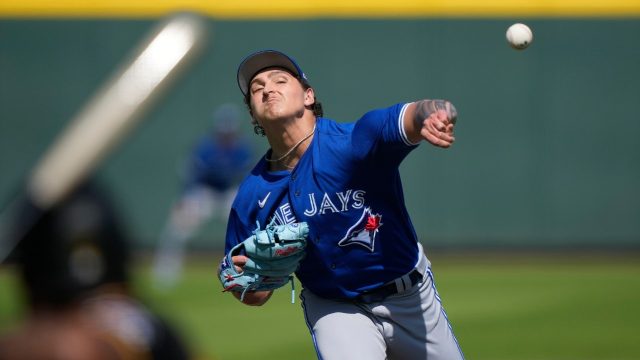
HOUSTON – What’s Whit Merrifield’s first impression of the designated pinch-runner rule Major League Baseball is testing out in the Atlantic League this season?
“That’s horrible,” said the Toronto Blue Jays utilityman, part of the 11-member Competition Committee that includes six ownership representatives, four players and one umpire. “Maybe the Atlantic League will like it. Hopefully, not in my lifetime will that be up here.”
The concept allows teams to list one player not in the starting lineup as a designated pinch runner who can be subbed in for anyone who reaches base, with both players eligible to return later in the game.
Major League Baseball is also testing out a single disengagement for pitchers per at-bat – they’re allowed two under this year’s rules in the big leagues – and extending the “Double Hook” rule, which eliminates a team’s designated hitter if the starter doesn’t pitch five innings.
The former is another way to further speed up games, while the latter is aimed an incentivizing the use of starters deeper into games, rather than running out an array of high-velo relievers.
Use of a rule in the Atlantic League doesn’t mean a big-league arrival is imminent, but several rules implemented in recent years, including the three-batter minimum for relievers, bigger bases and ban on infield shifts, were first evaluated there before advancing to the minors.
Of the three rules in the mix this summer, a designated pinch runner carries the potential to most dramatically alter the way games are played and strategized and teams are constructed, which is what bothers Merrifield.
“There are three parts to being a major-leaguer: being able to hit, being able to play defence and being able to run the bases,” said Merrifield. “You don’t have to be fast, but you need to run the bases if you want to be an all-around baseball player. To basically have somebody come in and do that, we’re just slowly getting away from what the game, I feel like, was made to be.”
Having a speedster on the bench eligible to come in and out of games would allow teams to carry bat-only players and not worry about them clogging up the basepaths. Although that would create pathways to roster spots for one-tool players, it would also subtract from the advantages of teams with multi-tool players and deep rosters.
Blue Jays manager John Schneider is intrigued by a concept “you see in the playoffs, where teams carry guys on the roster just to go out and pinch run.”
“It’s interesting. We’ll see how it plays out,” he continued. “But whenever they’re trying something, there’s usually some traction to it. … There’s always going to be a time, and you can look at our roster for sure, where it’s like it’d be a good time to have a burner in there as opposed to (Alejandro) Kirk or (Brandon) Belt, you know? It’s definitely interesting.”
Having more speedsters on the bases would increase the pressure on pitchers to hold runners and catchers to throw them out, at a time when there are already restrictions on the number of times a pitcher can throw over.
“It’s weird. I don’t know how I feel about it,” said Blue Jays catcher Danny Jansen. “It probably opens up opportunities for people to maybe be on a big-league roster to do that. It creates pretty much a position. But, at the same time, it’s just a lot, you know what I mean? I understand the goal for more action with all the rules this year. That just seems like a lot.”
Other rule ideas to debut in the Atlantic League are the dropped pitch rule, pushing the pitching rubber back and the calling of automated balls and strikes using TrackMan technology.
As for the current trio of changes, “none of this stuff has been relayed to players, so that kind of tells you where it’s at in the process,” said Merrifield. “I think it’d be quite an uprising if (commissioner Rob) Manfred came out and said, ‘Yeah, that’s what we’re going to do next year or the year after.’ That wouldn’t be good, I don’t think.”
ROMANO’S SLIDER-FEST: Fifteen pitches to record four outs isn’t unusual for All-Star closer Jordan Romano. Fourteen sliders in 15 pitches, on the other hand, sure is.
“Me and Kirky (catcher Alejandro Kirk), we just thought the boys wanted heaters today, know what I mean?” Romano said after recording his first four-out save of the season in Tuesday’s 4-2 win over the Houston Astros. “We could kind of tell from some of the swings they were sitting heater. So, we just went heavy slider.”
Tuesday’s outing wasn’t an aberration, even if it was an extreme manifestation of an early-season trend. Although his pitch usage last year was split nearly even between his fastball (47.9 per cent) and slider (51.8 per cent), so far in 2023 the split is dramatically tilted toward slider at 68.3-30.3 per cent.
It’s been a weapon, too, with an astonishing 47.4 whiff rate.
“I feel like my slider right now is better than it was last year,” said Romano. “I just feel more comfortable with the shape, it’s a little bit better, I like how I command it. I don’t feel like it’s better than the heater. The velo I feel like is pretty solid on the heater right now. It’s outing to outing. I feel very confident with both pitches, so whatever the catchers throw down, I’m not going to second guess it too much.”
The only fastball he threw to the Astros was ripped for a single by Jake Meyers and although he thought about showing them another fastball or two to speed them up before slowing them down, he ultimately decided to stay breaking ball.
“A lot of those guys are good fastball hitters, so I really just didn’t want to give them too many chances. I liked the slider match-up,” he said. “Yeah, it’s unusual throwing just one heater for four outs, I don’t know if that’s going to happen too many more times, but it happened (Tuesday).”
CHAPMAN KEEPS CRUSHING: Matt Chapman felt he pulled the ball too often last year and made some changes over the winter designed to have him use the entire field again, the way he did earlier in his career.
The results in a torrid start have supported the shift, with four of his five home runs hit to right-centre or right, and a near totally balanced batted-ball profile. That’s led to a .415/.472/.785 batting line along with 100th percentile average exit velocity (97.4 mph) and hard-hit percentage (66 per cent).
“It just gives me confidence and trust that approach works,” said Chapman. “I’ve been able to get some more hits, maybe hit the breaking ball a little bit better, stay back on the baseball and not try to do too much. Obviously, it’s nice things are going good right now. I know it’s a long season, but it’s nice to start off like this and feel like I’m helping the team win. But that approach is going to be able to keep me more consistent throughout the season and be able to know that when things maybe aren’t going good, I have something to go to and have something I know that works to help me get back on track.”








